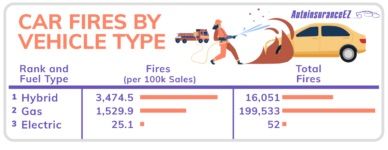
Myth: EVs Are A Fire Risk
Yet another myth that I see on a regular basis, is that EVs are more likely to catch fire.
In actual fact, there is an element of truth to the claim, but to suggest that EVs catch fire more often is blatantly misleading.
When looking at the number of vehicle fires per 100,000 units, hybrid vehicles (those with both an internal combustion engine and an electric motor) have the most fires. I’ve looked at statistics from both America and Australia, both of which make it clear.
Fully electric vehicles are recognised as being far less likely than both hybrids and petrol or diesel cars to catch fire. For EVs, it is ‘just’ 25.1 fires per 100,000 sales and that compares to 3,474 hybrid fires and 1,529 ICE fires per 100,000 sales respectively. [data is from USA as I’ve had difficulty locating data from the UK].
The lithium batteries in EVs result in different types of fire characteristics to those seen in cars with petrol or diesel engines. The EV batteries produce poisonous fluoride gases when on fire, but take much longer to develop. For the driver and any passengers, this means they are far more likely to have time to escape the fire before things really take hold.
However, EV fires do burn for a long time, and are harder to put out. The thing is that pure ICE cars are over 60 times more likely to catch fire in the first place an hybrids are over 138 times more likely to go up in flames.
So, EVs aren’t the big risk

It is pretty obvious that cars with internal combustion engines have far more areas where a fire can start. There are hundreds of moving parts, lots of oils and pipes, and the flammable fuels themselves. So, it’s no wonder that cars with an internal combustion engine pose a greater risk than those without.

We need your consent to load the translations
We use a third-party service to translate the website content that may collect data about your activity. Please review the details in the privacy policy and accept the service to view the translations.
